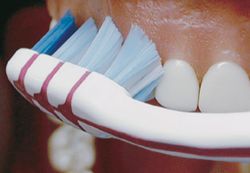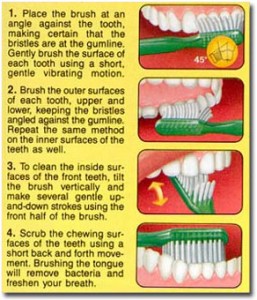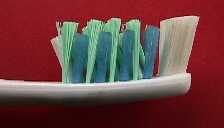Many toothbrushing methods have been introduced during the last 50 years and most are identified by an individual’s name, such as Bass, Stillman, Charters, or by a term indicating a primary action to be followed, such as roll or scrub. No one method shows consistently better results in removing plaque than scrubbing. Most people brushing with an instructed professional method are not aware that they are brushing in a specific way. Therefore it may be more effective for individuals to improve their own method.
Various toothbrushing techniques will be briefly described here. The toothbrushing methods most emphasized are horizontal scrub, Fones, Leonard, Stillman, Charters, Bass, rolling stroke (press roll), and Smith-Bell. All of these techniques are applicable to the cleaning of the facial (tooth surface that faces outside), lingual (tooth surface that faces inside the mouth), and to some extent to occlusal (chewing) surfaces; all are relatively ineffective in cleaning the areas between teeth; and only the Bass technique is effective in cleaning the fissures in the gums.
Natural Methods of Tooth Brushing
The most natural brushing methods used are a back-and-forth horizontal scrub technique, a rotary motion (Fones’s technique), or a simple up-and-down motion over the upper and lower teeth (Leonard’s technique). Those managing effective toothbrushing with these methods without causing traumatic problems to the mouth or disease should not alter their brushing methods just for the sake of change.
Stillman’s method was originally developed to provide stimulation to the gums. The toothbrush is positioned with the bristles inclined at a 45-degree angle to the long axis of the tooth, with part of the brush resting on the gums and the other part on the tooth. A vibratory motion is used with a slight pressure to stimulate the gums. The brush is lifted and then replaced in the same area, and pulsing motion is repeated.
Charters recommends a pressure-vibratory technique to clean areas between teeth. The toothbrush should be placed at a 90-degree angle to the long axis of the teeth so that the bristles are gently forced between the teeth but do not rest on the gums. The brush is moved in several small rotary motions so that the sides of the bristles are in contact with the gum margin. After two or three such motions, the brush is removed and replaced in the same area and the motions are repeated.
The Bass technique was the first to focus on the removal of plaque and debris from the gumline (gum sulcus) by the combined use of a soft toothbrush and dental floss. The method is effective for removing plaque adjacent to and directly beneath the gum margins as part of the self-care regimen for controlling gum disease and cavities. In the Bass technique, the toothbrush is positioned in the gumline at a 45-degree angle to the long axis of the tooth. The bristles are then gently pressed to enter the sulcus. A vibratory action, described as a back-and-forth horizontal jiggle, causes a pulsing of the bristles to clean the gumline. Ten strokes are advised for each area.
In the rolling-stroke method, the toothbrush bristles are positioned parallel to and against the attached gums, with the toothbrush head level with the occlusal (chewing) plane. The wrist is then turned to flex the toothbrush bristles first against the gums and then the outer surface of the tooth. A sweeping motion is continued until the chewing surface or tip of the tooth is reached. The toothbrush bristles are at right angles to the tooth surface as the brush passes over the crown. The press roll action is repeated at least five times before proceeding to the next site.
Modified brushing methods
In attempts to enhance brushing of the entire outer surface and inner tooth surfaces, the original techniques have been modified. Some modifications like the Bass method may induce a more pronounced trauma to the gums with standard brushes. New toothbrush designs such as multilevel and cross-section bristles that have been tested are not only more effective but can be also less harmful.
The following considerations are important when one wants to learn a particular toothbrushing technique:
- the individual’s oral health status, including number of teeth, their alignment, the individual’s mouth size, presence of removable prostheses, orthodontic appliances, periodontal (gum) pockets, and gum condition;
- the individual’s systemic health status, including muscular and joint diseases, and mental retardation;
- the individual’s age;
- the individual’s interest and motivation;
- the individual’s manual dexterity; and
- the ease and effectiveness with which the professional can explain and demonstrate proper toothbrushing procedures.



